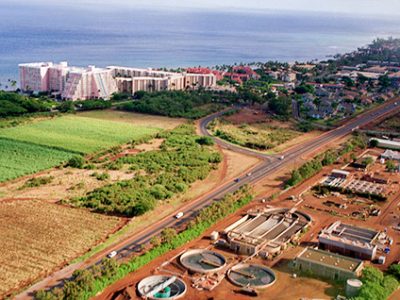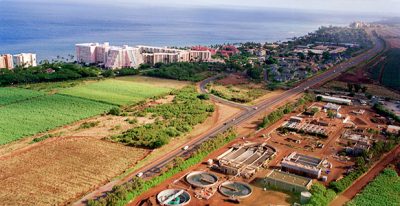
This week the U.S. Supreme Court issued its decision in the Court’s most important environmental law case of the current Term: County of Maui v. Hawaii Wildlife Fund. In a somewhat surprising ruling, the justices rejected both sides’ argument over the scope of government authority to regulate water pollution discharges under the federal Clean Water Act (CWA). The Court instead fashioned a Solomonic outcome, adopting a middle ground and legal rule that neither the County, the environmental group plaintiffs or the Trump Administration had advocated. On balance, however, County of Maui represents a positive result for environmental interests, one that notably drew support from two of the Court’s conservative justices. And County of Maui provides a couple of fascinating political backstories as well.
The case involves a county-owned and operated sewage treatment plant on the coast of Maui, Hawaii. The facts were undisputed: the plant collects from around the island of Maui and partially treats sewage before pumping four million gallons of effluent-laden water per day into the subsurface groundwater aquifer. That effluent then migrates from the plant site a half mile, via subsurface groundwater channels, to the shoreline, where it empties into the Pacific Ocean. The County has neither sought nor obtained a permit from the U.S. Environmental Protection Agency to discharge these water pollutants into navigable waters.
In 2012, local environmental organizations filed a citizen suit against the County, asserting that the County was in violation of section 401 of the CWA. Specifically, the plaintiffs argued that the County was “discharg[ing]” a “pollutant” into “navigable waters” without a USEPA permit as mandated under the CWA. The County defended the case by arguing that while a CWA permit would have been required if its plant had discharged its sewage effluent directly into the ocean, the fact that the County instead first pumped it underground and let the groundwater channel carry it to the ocean removed the discharge from the scope of CWA permit jurisdiction.
Both the federal district court and the U.S. Court of Appeals for the Ninth Circuit ruled in favor of the environmental plaintiffs, finding that the County was in violation of the CWA. The Ninth Circuit in its decision found that a CWA permit is required when “pollutants are fairly traceable from the point source to a navigable water,” and that the County’s sewage discharges met this standard.
The Supreme Court granted the County’s petition for certiorari. The Trump Administration filed a friend-of-the-court brief in support of the County’s position that no CWA permit was required.
In a 6-3 decision authored by Justice Stephen Breyer, the Court affirmed the lower courts’ rulings, but disagreed as to the applicable legal standard, and with the arguments advanced by both sides. Rejecting the County’s and federal government’s claims that CWA jurisdiction over the plant’s discharges is lacking if the pollutants are discharged into groundwater before they find their way to the ocean, Justice Breyer concluded that such an interpretation of the CWA “is too narrow, for it would risk serious interference with EPA’s ability to regulate ordinary point source discharges.”
But the Court majority also spurned the environmentalists’ reliance on the Ninth Circuit’s finding that the applicable test is whether the pollutants are “fairly traceable” from the sewage treatment plant to the ocean. That standard, Justice Breyer wrote, would result in too expansive an application of CWA jurisdiction, one inconsistent with Congressional intent, legislative history and common sense.
Instead, Justice Breyer announced an intermediate test to determine the appropriate scope of CWA permit jurisdiction–one he had initially floated during oral arguments in the case last fall. The correct standard, Breyer concluded, is whether “the addition of the pollutants through groundwater is the functional equivalent of a direct discharge from the point source into navigable waters.” (Emphasis added.)
Finally, Breyer attempted to put some jurisprudential meat on the bones of his “functional equivalent” test. Acknowledging that this test is not as clear-cut in application as either the bright-line rule advocated by the County or the expansive standard favored by the environmental groups and the Ninth Circuit, Breyer identified several specific criteria for lower courts to consider in future cases. The most important, Breyer stressed, are: 1) the amount of time it takes the pollution to travel from the point source to navigable waters; and 2) the linear distance between the two.
The voting pattern in County of Maui is somewhat unusual: in addition to capturing the Court’s other three progressive justices, Justice Breyer obtained the votes of Chief Justice Roberts and Justice Kavanaugh. Justice Thomas wrote a dissent in which Justice Gorsuch joined, while Justice Alito dissented separately.
On balance, County of Maui represents a significant win for environmental interests. Most importantly, it rejects the County’s formalistic “intervening element” theory in favor of a more environmentally protective (if fact-dependent) legal standard. The Court’s interpretation also seems far more consonant with Congressional intent regarding the CWA’s regulatory scope and ultimate goals.
The Court’s decision is atypical in one respect: in recent years, the Supreme Court has rather consistently reversed the Ninth Circuit in environmental cases. County of Maui is a major departure from that trend. Additionally, the decision provides evidence that the conservative wing of the Court will not, as a block, reflexively take the “anti-environment” position in cases coming before it. Future litigants arguing environmental causes before the Supreme Court will likely focus their advocacy on Chief Justice Roberts and (to a somewhat lesser extent) Justice Kavanaugh in seeking to secure a critical fifth vote in such cases.
Finally, the political backstories to which I alluded above: first, county officials–perhaps fearing the adverse ruling the Court ultimately handed down– attempted to settle the case while it was pending before the Supreme Court. But in an ugly and public political spat, the county’s mayor refused to support a proposed settlement council members had negotiated, and that settlement was never consummated.
Second, while the County of Maui case was pending before the justices, the Trump Administration’s USEPA hurriedly issued an “Interpretative Statement” embracing the same narrow interpretation of CWA permit jurisdiction the county was arguing before the Court. The majority opinion observed that EPA’s 2019 interpretation abandons the more expansive position on the scope of CWA jurisdiction that USEPA had applied “for over 30 years.” The Court noted in passing that no party or amici had asserted that USEPA’s new Interpretive Statement was entitled to so-called Chevron deference from the courts. It also dryly opined that the Trump Administration’s newly-announced stance on the scope of CWA permit jurisdiction “interferes with EPA’s ability to regulate ordinary point source discharges” and creates a “large and obvious loophole”in the CWA.
Finally, it’s worth noting that County of Maui represents yet another court loss for the Trump Administration on the environmental law front–and the first handed down to date by the U.S. Supreme Court.

The post Here Today, Gone to Maui appeared first on Legal Planet.
By: Richard Frank
Title: Here Today, Gone to Maui
Sourced From: legal-planet.org/2020/04/25/here-today-gone-to-maui/
Published Date: Sat, 25 Apr 2020 08:31:20 +0000
Vist Maida on Social Me
Website Links
Maida Law Firm - Auto Accident Attorneys of Houston, by fuseology
PRESS RELEASE COVID-19 UPDATES
http://www.kake.com/story/41966303/covid19-maida-law-firm-is-open-and-fully-operational-during-this-crisis
https://legal-planet.org/2020/04/25/here-today-gone-to-maui/ https://legal-planet.org/wp-content/uploads/2020/04/Frank-400x300.jpg
No comments:
Post a Comment